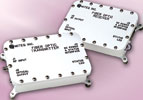

Fibre-optic (FO) technology has improved steadily in recent years to where optical links are now viable replacements for coaxial lines at broadband frequencies up to 20 GHz.
The versatility offered and design benefits provided by such links became apparent as the ability to transmit higher frequencies became available, leading to the development of a host of different microwave products and systems that utilise these unique benefits.
System designers who need to transmit RF and microwave signals over a distance of more than a few hundred metres will appreciate the advantages that a FO link has to offer versus conventional cable transmission. Typically, a single-mode optical fibre has less than 0,5 dB attenuation per kilometre and is capable of carrying light signals that are direct amplitude modulated (AM). Translating this into a specific application means that a system designer can capitalise on these attractive features and transmit a very large volume of data, voice and video signals over distances exceeding 20 km without having to be concerned about the prohibitively high insertion losses incurred through even the best performing coaxial cables.
With the increased use of complex electronic systems on aircraft and ships where weight and space are at a premium, a FO system with its light weight and small volume becomes even more attractive. But an optical link offers several other advantages. It is virtually immune to electromagnetic interference (EMI) and humidity, which are of paramount importance especially in the confines of a ship or an aircraft. FO links also insert optical isolation into a system, which means that the links are not very susceptible to interference from lightning. Furthermore, a fibre network offers a relatively secure transmission media.
Antenna remoting has become a key solution for FO links, as it allows for more front-end equipment to be moved away from the harsh outdoor environment at the antenna, and the sensitive equipment to be brought indoors into a controlled environment. This allows greater versatility and design options to the system engineer, as any possible design solutions can be considered. Outdoor equipment can be changed to indoor equipment that is typically at lower cost, yet can now be operated in a controlled environment that improves reliability and overall system performance.
Assuming 3 dB attenuation per 30 m of cable for a polystyrene coaxial cable at C-band frequencies, even a 50 dB gain LNA at the front end would lose its effectiveness after a few hundred metres. With optical fibre, the attenuation and the attenuation slope (not to mention shifts in phase and group delay), which are quite evident in coaxial cable, are almost non-existent. By performing an electrical-to-optical conversion close to the feed of the antenna, the signal can be transmitted several kilometres over fibre without significant attenuation.

FO links are ideal for use at stations where multiple antennas are present that have to be well separated in order to avoid side-lobe interference. FO links are easy to install and are less expensive to maintain than their coaxial counterparts. Other typical applications may include phased-array antennas, delay lines, conformal antennas and point-to-point links between facilities.
MITEQ, based on Long Island, NY, USA, has for the past decade been a developer of advanced RF-over-fibre solutions. The company’s fibre-optic links are capable of providing a 3 dB instantaneous bandwidth of 100 MHz to 18 GHz, while maintaining a noise figure and generous link gain over single-mode fibre-optic cables. The links operate at a wavelength of 1550 nm as standard, with other wavelengths offered on special request. By utilising multiple offset wavelengths, multiple fibre transmitters can be multiplexed onto a single fibre to ensure system design versatility.
The links consist of a transmitter and a receiver assembly that employ direct AM. In this design, the bias current of the laser is modulated by the incoming microwave signal that, in turn, modulates the amplitude of the laser output. When compared to a system using an external modulator, the direct-modulation technique has lower optical insertion loss.
The FO links can be specially configured to match specific applications (eg, with lower noise figures, higher intercept points, etc).
Many direct modulation FO links suffer from high insertion loss and limited dynamic range. This is in part due to the large impedance mismatch between the approximate 10 Ohm impedance of a laser diode and the typical 50 Ω impedance of a microwave system. To improve the dynamic range of the link, a Gallium-Arsenide (GaAs) monolithic microwave integrated circuit (MMIC) trans-impedance amplifier was developed in order to optimally match the RF system with the laser diode. The normally diverging optical output of the laser diode is first collimated to pass through an optical isolator and then focused into the fibre core.
For ease of use, all of the FO links have been designed to be self-contained. The transmitter module has built-in thermal stabilisation using a thermoelectric cooler (TEC). This cooler maintains the laser diode at a constant temperature by using feedback from a thermistor that is on the laser carrier. Laser diode thermal stabilisation helps minimise laser wavelength drifting. A good heatsink for the transmitter module would allow the TEC to shunt the heat optimally. In addition, a second feedback loop in the control circuit senses the output of a photodiode that is located at the back facet of the laser to maintain the laser optical power at a constant level through the laser ageing process. Both of the modules are provided with built-in regulators, reverse voltage polarity protection and are available in hermetically sealed packages.
| Tel: | +27 11 782 8728 |
| Email: | [email protected] |
| www: | www.accutronics.co.za |
| Articles: | More information and articles about Accutronics |

© Technews Publishing (Pty) Ltd | All Rights Reserved